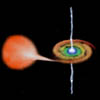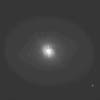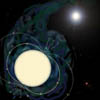News Archive
1996 |
1997 |
1998 |
1999 |
2000 |
2001 |
2002 |
2003
2004 | 2005 | 2006 | 2007 | 2008 | 2009 | 2010 | 2011
2012 | 2013 | 2014 | 2015
2004 | 2005 | 2006 | 2007 | 2008 | 2009 | 2010 | 2011
2012 | 2013 | 2014 | 2015
![]()
Welcome to our archive of past news articles.
You will find previous articles listed below
from most the recent back to our first articles in 1996.
2002
 |
Exotic Innards of a Neutron Star Revealed in a Series of Explosions [25 November 2002] - Amidst the fury of 28 thermonuclear blasts on the surface of a neutron star, scientists using the European Space Agency's XMM-Newton X-ray satellite have obtained a key measurement revealing the nature of matter inside these enigmatic objects. |
 |
Chandra Discovers The History Of Black Hole X-Ray Jets [13 November 2002] - For the first time, astronomers have tracked the life cycle of X-ray jets from a black hole. A series of images from NASA's Chandra X-ray Observatory revealed the jets traveled at near light speed for several years before slowing down and fading. |
 |
Europe opens a window onto a violent Universe [17 October 2002] - On 17 October 2002, the European Space Agency launched a new observatory set to revolutionize the branch of astrophysics that seeks to unravel the secrets of the highest-energy, and therefore the most violent, phenomena in the Universe. This comes 20 years after the end of ESA's COS-B mission, which produced a complete map of the sky in the high-energy gamma-ray waveband. |
 |
Riccardo Giacconi Awarded Nobel Prize For Pioneering Work In X-Ray Astronomy [10 October 2002] - More than 100 years ago, the first Nobel Prize in physics was awarded to Wilhelm Röntgen for his discovery of X-rays. This week, Riccardo Giacconi was recognized with a share in the Nobel Prize in physics for his pioneering work in X-ray astronomy. |
 |
Space Movie Reveals Shocking Secrets of the Crab Pulsar [20 September 2002] - Just when it seemed the summer movie season had ended, two of NASA's Great Observatories have produced their own action movie. Multiple observations made over several months with NASA's Chandra X-ray Observatory and the Hubble Space Telescope captured the spectacle of matter and antimatter propelled to nearly the speed of light by the Crab pulsar. |
 |
Scientists Observe Light Fighting to Escape
Black Hole's Pull [02 July 2002] - Scientists have found new evidence that light emanating from near a black hole loses energy climbing out of a gravitational well created by the black hole, a key prediction of Einstein's theory of general relativity. |
 |
Going, going, almost gone: Pulsar whittles away stellar companion to planet-size [30 May 2002] - Scientists at the Massachusetts Institute of Technology have found a pulsar in a binary star system that has all but completely whittled away its companion star, leaving this companion only about 10 times more massive than Jupiter. |
 |
Retired Quasars Live on to Generate the Fastest, Most Energetic Cosmic Rays [22 April 2002] - They are old but not forgotten. Nearby "retired" quasar galaxies, billions of years past their glory days as the brightest beacons in the Universe, may be the current source of rare, high-energy cosmic rays, the fastest-moving bits of matter known and whose origin has been a long-standing mystery, according to scientists at NASA and Princeton University. |
 |
Scientists Detect First Afterglow of Short Gamma-Ray Bursts [01 March 2002] - In the powerful realm of gamma-ray bursts, scientists say they have detected for the first time a lingering afterglow of the shortest types of bursts, which themselves disappear within a second. |
 |
Coming to a Theater Near You -- The Stormy Sun [12 February 2002] - Lights, camera, action! With the launch of NASA's High Energy Solar Spectroscopic Imager, or HESSI, scientists will capture high-fidelity color movies of the most powerful events in the Solar System -- solar flares. |
 |
"Local" Gamma-Ray Bursts Are Newest Pieces of Puzzle [28 January 2002] - Don't look now, but some gamma-ray bursts may be closer than you think. Although scientists have believed for some time that most gamma-ray bursts originate from the farthest reaches of the Universe, a NASA Goddard scientist has discovered about 100 of them that are quite "local," within 325 million light years from Earth. |
1996 |
1997 |
1998 |
1999 |
2000 |
2001 |
2002 |
2003
2004 | 2005 | 2006 | 2007 | 2008 | 2009 | 2010 | 2011
2012 | 2013 | 2014 | 2015
2004 | 2005 | 2006 | 2007 | 2008 | 2009 | 2010 | 2011
2012 | 2013 | 2014 | 2015
Take Me to the News Page

